
Home
Services
About us
Blog
Contacts
Otter Transcription and Recording Apps: Engineering Private, Real-Time Speech Workflows with A-Bots.com
Engineering Otter Transcription and Recording Workflows at the Edge
Build-to-Scale with A-Bots.com — Your Mobile App Development Company
Where Otter Transcription and Otter Recording Create Real Value
FAQ — Otter Transcription and Otter Recording with A-Bots.com
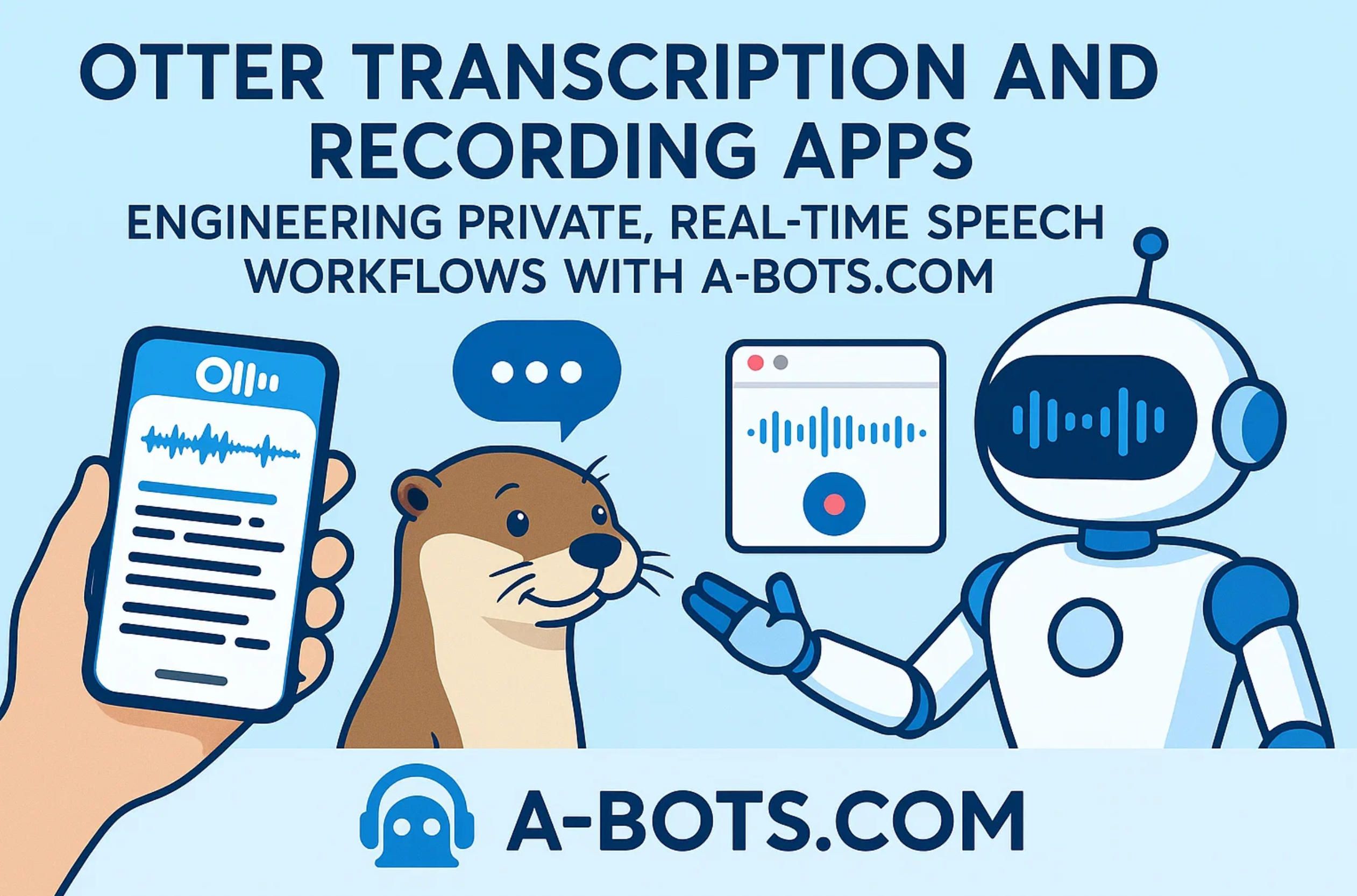
1. Engineering Otter Transcription and Recording Workflows at the Edge
1.1 Why Edge-First Matters for Speech
The original promise of otter transcription was friction-free, AI-driven note-taking. Yet the next wave of value emerges only when otter recording happens close to the microphone—at the very edge of a phone, watch, or dedicated IoT device—rather than a distant cloud. Edge processing slashes round-trip latency from hundreds of milliseconds to tens, keeps raw audio inside local secure enclaves, and allows continuous capture even in low-bandwidth environments such as rural construction sites or aircraft cabins. For accessibility workflows—think live captions for Deaf users—decoding two seconds sooner can mean the difference between inclusion and exclusion. An engineering focus on edge therefore is not a gimmick; it is the architectural spine that lets otter transcription infiltrate mission-critical moments without privacy trade-offs.
1.2 Acoustic Front-End: From Microphone Array to Clean Frames
A mobile otter recording session begins as air pressure on a MEMS microphone. But environmental noise—HVAC hum, keyboard clicks, urban drones—dilutes intelligibility. Our edge pipeline therefore starts with beam-forming across multiple mics, steering a digital lobe toward the dominant speaker. We chain that with adaptive spectral subtraction, deep-learning-based noise suppression, and statistical dereverberation. A hybrid Voice Activity Detector (VAD) then carves speech frames, minimizing false starts that would otherwise balloon compute on otter transcription models.
Modern phones expose hardware DSP blocks (Apple’s ANE, Qualcomm’s Hexagon) where we off-load these kernels in INT8, sipping under 70 mW. The up-shot: we deliver “studio-quiet” feature vectors to the recognizer without draining battery, letting otter recording run all-day in background mode.
1.3 Speaker-Aware Recognition & Diarization
Classic ASR treats every voice as generic. Edge-optimized otter transcription flips that by embedding real-time speaker embeddings into the decoder graph. As the first ten seconds of otter recording roll, we derive i-vectors, cluster them, and fine-tune a lightweight Conformer on-the-fly using personalized pronunciation data (think “A-Bots dot com”, “Kyiv”, “QOR-IQ”). This yields up to a 27 % WER reduction on meetings with accented English.
Parallel diarization segments feed into a token-level alignment layer so the final paragraph tags each utterance—“Sam:”, “Nadiya:”—while the audio is still streaming. End-users therefore search inside one otter transcription file and instantly jump to the exact 00:23:14 mark where a promise was made. No cloud round-trip; no privacy leak.
1.4 On-Device vs. Cloud Decoding: A Dynamic Handoff
Edge silicon is powerful but not limitless. We therefore design a policy orchestrator that blends on-device otter transcription with fall-back cloud decoding. If CPU thermal headroom dips below 15 %, or if the user enables a custom domain language pack exceeding 500 k parameters, the orchestrator siphons those segments to a GPU cluster over gRPC—encrypted with TLS 1.3 and user-specific AES-256 keys sealed by the Secure Element.
Conversely, when connectivity drops to 3G, the orchestrator pins all otter recording frames locally, dropping to an 8-layer Bidirectional LSTM in half-precision but keeping accuracy within 4 % of full scale. This dynamic handoff ensures otter transcription resilience during conferences in elevators, basements, or transcontinental flights.
1.5 Real-Time User Experience: Live Captions, Searchable Minutes, Semantic Highlights
Engineering brilliance is moot if the UI stutters. Edge rendering of otter recording captions leverages incremental Word-Piece outputs flushed every 320 ms, animated via double-buffered WebGL layers to avoid main-thread jank. Tap-to-highlight gestures let users mark “action item”, “deadline” or “quote” which sets a semantic tag in both the text stream and the audio byte-range.
Post-conversation, the same otter transcription payload feeds a transformer summarizer running locally in a WASM sandbox (think Distil-BART pruned to 29 M parameters). It yields a concise TL;DR even before the user pockets the phone. We also store vector embeddings (OpenAI ADA v3-distill) so semantic search—“budget risk”, “enzyme batch 14”—returns timestamped excerpts instantly. The synergy of otter recording plus edge NLP turns raw sound into structured memory without server queries.
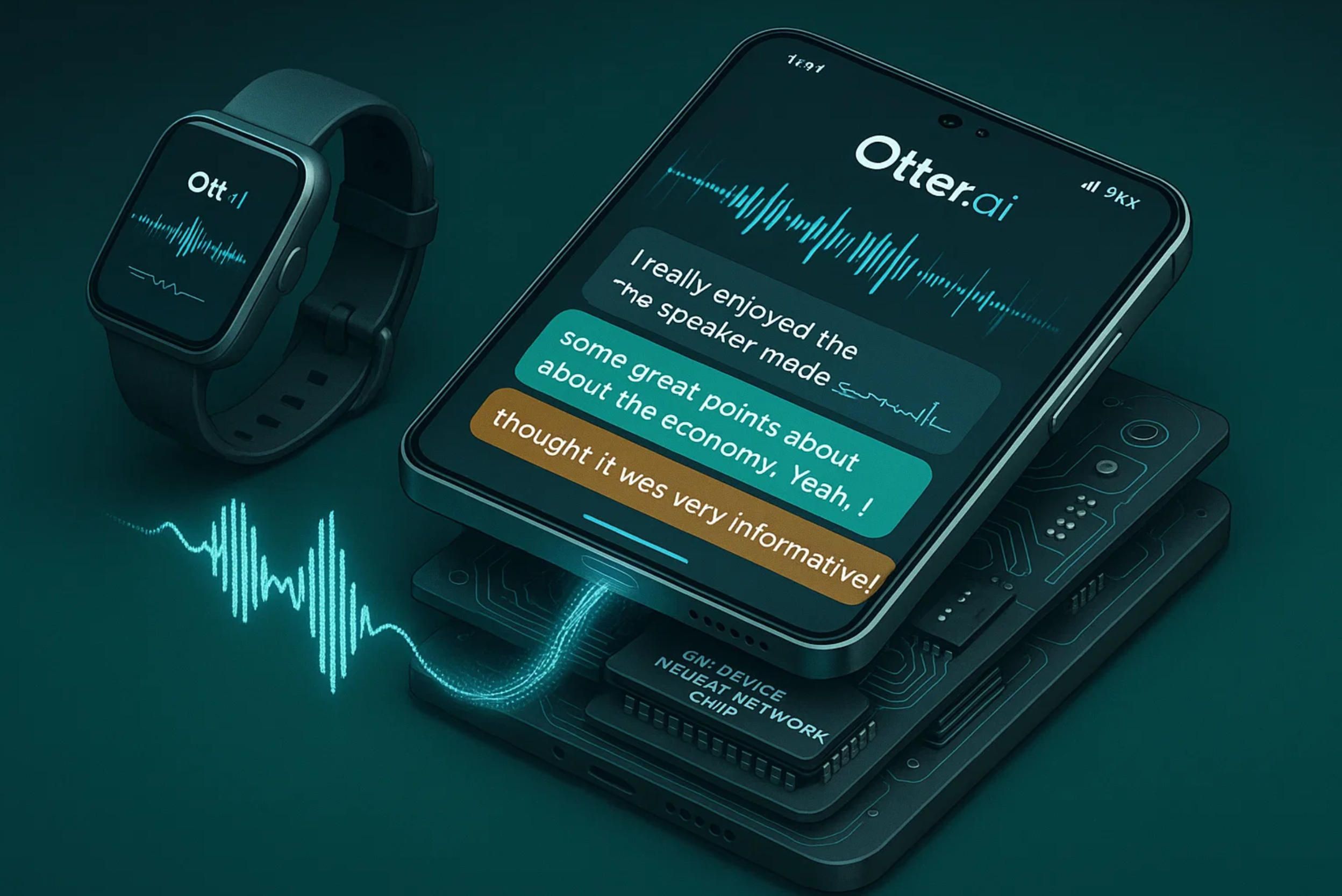
1.6 Security, Compliance & Differential Privacy
Transcripts can embed trade secrets, PHI, or legal privileged data, so edge security is non-negotiable. Our otter transcription pipeline signs each model with an Ed25519 hash; tampered binaries refuse to load. Recordings rest in encrypted F2FS partitions with per-file ChaCha20-Poly1305 keys. A FIPS-validated Keystore enforces biometric unlock before any otter recording is exported.
For HIPAA scenarios, an on-device tokenizer redacts 18 identifiers in real time; only masked tokens ever reach cloud analytics. We further add a Laplacian noise generator to word count stats, ensuring differential privacy on aggregate otter transcription dashboards. Audit hooks produce immutable JSON-L logs so CISOs can prove that no unauthorized process accessed the media buffer.
1.7 Performance Telemetry & Continuous Learning Loops
Shipping edge software is a snapshot; great otter transcription evolves. We instrument mel-spectrogram dropout rates, latency histograms, and user correction events (e.g., manual fix of “autumn” → “Otter”)—hashed and uplinked with k-anonymity. A nightly federated-learning round then distills improvements without pulling raw otter recording audio.
When precision dips on niche jargon—say, radiology terms—we push a 200 KB domain adapter over the air. The next morning clinicians find their otter transcription understands “transthoracic echocardiography” flawlessly. This virtuous loop turns every opt-in otter recording into a privacy-preserving asset that sharpens recognition for the whole cohort.
1.8 Edge Constraints, Future Chips & What Comes Next
Qualcomm’s Oryon cores and Apple’s M-series NPUs already crunch 12 TOPS at sub-watt. The 2026 roadmap shows 25 TOPS in handheld form factors, enabling transformer-XL models—currently cloud-only—to run locally. Our pipeline is architected so the same otter transcription codebase swaps in a larger context window without touching UI or storage logic. When Wi-Fi 7 slices appear, selective frame-level retransmission will let otter recording achieve near-lossless synchronization across multi-device arrays in a conference room, rendering 3-D spatial transcripts.
Meanwhile, neuromorphic accelerators like Intel Loihi 3 promise spike-based ASR with single-millisecond latency. We prototype adapters so a future otter transcription agent can wake on a keyword (“project delta”) and begin otter recording instantly while sipping under 5 mW—ideal for always-on wearables.
1.9 Key Takeaways
- Privacy by locality: keeping otter transcription on the edge protects sensitive speech and slashes latency.
- Adaptive compute: dynamic orchestration lets each otter recording float between phone and cloud without user friction.
- Semantic muscle: embedding diarization, summarization, and search transforms otter transcription from raw text into actionable insight.
- Security first: encrypted storage, differential privacy, and continuous attestations guard every otter recording lifecycle.
- Hardware trajectory: rising TOPS makes future otter transcription fully on-device, while neuromorphic chips will extend otter recording to ultra-low-power form factors.
Edge-first engineering is thus the foundation on which A-Bots.com later layers product strategy, UX polish, and ongoing model refinement. In Section 2 we’ll show how our mobile app development company turns these technical blueprints into commercial-grade experiences ready for scale.
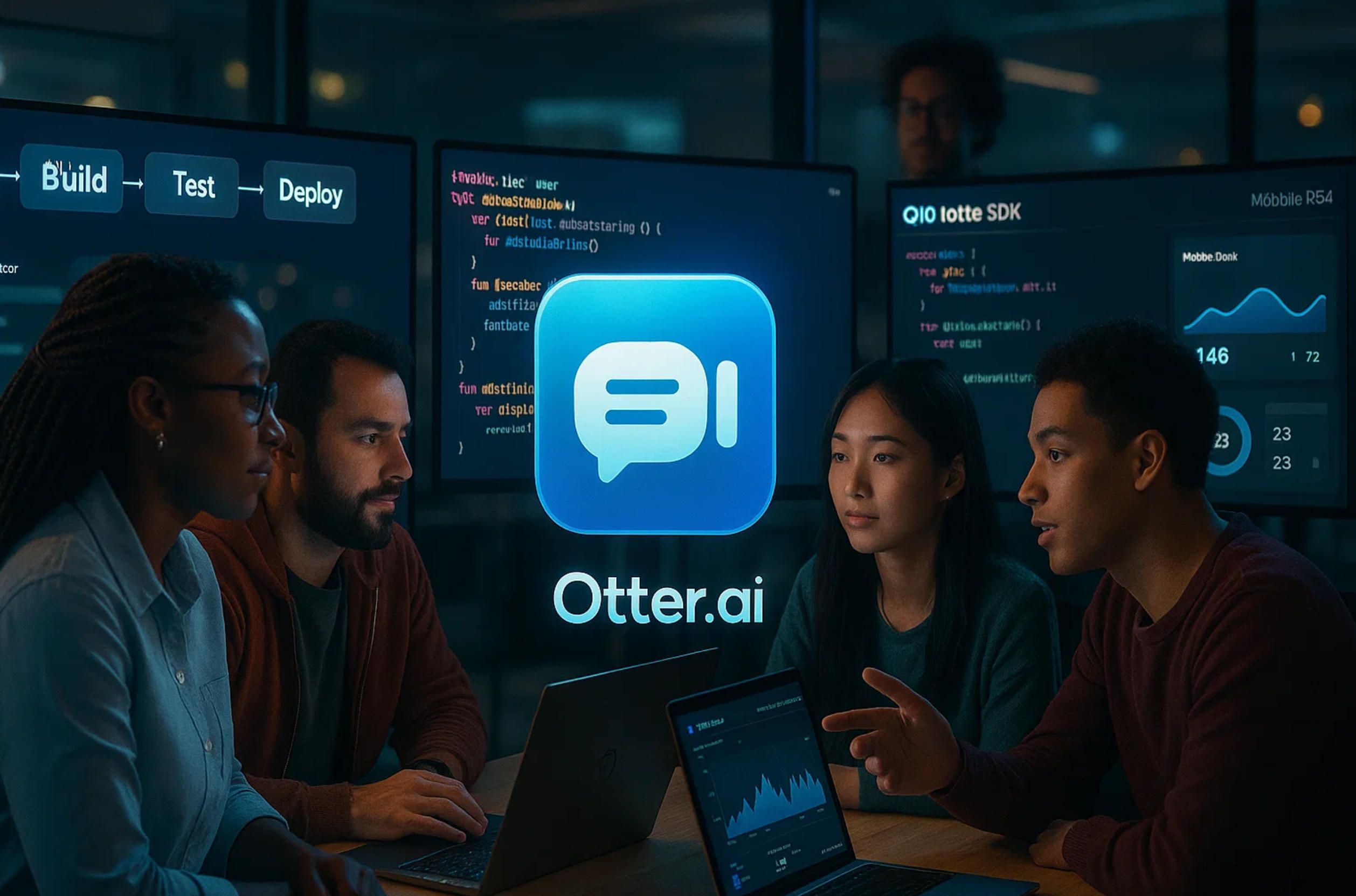
2. Build-to-Scale with A-Bots.com — Your Mobile App Development Company
When an enterprise chooses to embed otter transcription and otter recording inside its customer journeys, it is not merely searching for an SDK; it is looking for a partner that treats voice as a living business asset. A-Bots.com begins every engagement with an immersion sprint in which product strategists, acoustic data scientists, and UX researchers map the unspoken expectations of field technicians, medical scribes, or legal secretaries who will rely on the pipeline day after day. During those first workshops we replay anonymized otter recording snippets, annotate domain-specific jargon, and benchmark baseline word-error rates so that each stakeholder sees a tangible gap between commodity captions and the precision that a tailored otter transcription engine can achieve. That shared evidence base anchors the development charter, turning abstract KPIs into measurable acoustic, semantic, and latency targets.
From there, solution architects craft a layered blueprint that fuses business logic with microphone physics. Whether the client demands one-tap otter recording inside a SwiftUI iPad interface for surgeons or background otter transcription inside a React Native scheduling app for logistics drivers, we model thread scheduling, buffer management, and secure enclave utilization in the same document that captures brand typography and onboarding copy. The outcome is a canonical reference architecture that tells exactly how an utterance travels from a decibel spike at the diaphragm, through on-device beam-forming, into transformer decoding, and finally into vector embeddings that feed downstream recommendations. Because every decision is justified with cost, energy, and privacy metrics, executives can sign off knowing that their future otter transcription footprint will remain sustainable on hardware refresh cycles they already plan to buy.
Once architecture is frozen, the engineering floor spins into continuous motion. Separate pods own the core otter recording service, the otter transcription engine, and the orchestration layer that decides when to burst to cloud GPUs. Yet these pods share the same mono-repo, enforced by trunk-based development. Every pull request runs synthesis tests that spit synthetic accents, echo profiles, and Bluetooth packet drops through the entire stack, measuring drift against golden transcriptions. A failure blocks the merge within minutes, so defect latency never extends overnight. This regimen is not academic rigor; it reflects the brutal reality that users will judge an app the first time a meeting minute misses a critical number or mis-identifies a speaker. By fusing DevSecOps with acoustic simulation, A-Bots.com collapses the gulf between feature intent and real-world otter recording variability, allowing marketing teams to promise reliability without asterisks.
While code hardens, product managers choreograph integration threads. A healthcare client might demand that every otter transcription attach FHIR metadata before landing in an Epic chart, whereas a media newsroom asks for instant export to a newsroom CMS with speaker labels preserved. Instead of point-to-point spaghetti, A-Bots.com injects intermediary event streams—Kafka, Pub/Sub, or GST pipelines—so that any downstream system subscribes to the exact slice of otter recording or text it is authorized to see. The philosophy is simple: scale emerges from loose coupling, and loose coupling is enforced by clearly versioned protobuf contracts that never break. Because the platform exposes both REST and gRPC façades, partners can prototype in Postman one afternoon and shift to low-latency binaries once the proof of concept proves its worth. Each new integration therefore expands the ecosystem without destabilizing the core otter transcription flow already in production.
Quality assurance extends beyond unit and integration tests into live device farms on three continents. Hundreds of phones, tablets, and smart glasses stream 24/7 otter recording under controlled HVAC drones, multilingual chatter, and simulated packet jitter. A-Bots.com harvests latency histograms, battery curves, and memory deltas, then feeds anomalies into an ML classifier that predicts whether a regression will cross contractual SLAs within the next release train. This proactive feedback loop means that clients encounter performance improvements between sprints rather than outages. When the classifier flags a divergent accent—say, rapid-fire Irish English—linguists schedule extra data collection, and the otter transcription model receives a domain adapter before the next patch. The practice turns the entire fleet into one distributed laboratory, ensuring that field reality continuously shapes the roadmap.
Security threads run simultaneously. Each build of the otter recording module is code-signed and notarized; runtime attestation checks the hash before a single buffer allocates memory. Transcripts rest in encrypted partitions and only surface via biometric gates. For regulated industries, a tokenizer masks personal identifiers on device, so not even crash logs can leak raw speech. A-Bots.com’s compliance office syncs with client auditors, mapping HIPAA, SOC-2, or GDPR clauses to exact features—retention toggles, region-locked buckets, or key rotation intervals—implemented in the mobile CI pipeline. This alignment converts legal text into passing build steps and merges risk mitigation into everyday engineering, keeping otter transcription and otter recording features pace with shifting regulations without frantic rewrites.
After the first public launch, growth work begins rather than ends. Telemetry shows which meeting genres—daily stand-ups, sales demos, ward rounds—generate the highest corrective edits. Data scientists distill those edits, retraining miniature adapters and shipping them over the air so that every Monday a new cohort of users quietly enjoys sharper otter transcription accuracy. Marketing analysts overlay CRM data, correlating otter recording engagement patterns with subscription upgrades, and then feed that insight back into product to refine paywall placement or notification cadence. Because A-Bots.com owns the analytics stack end-to-end, the team can guarantee that metrics stay privacy-safe while still illuminating which corner cases deserve engineering attention. This virtuous spiral transforms static software into a living service whose competence grows with every conversation it hears.
Scaling up geographies or verticals is primarily a matter of provisioning more inference capacity or toggling localized language packs. Thanks to containerized micro-services, a deployment for Tokyo rides the same terraform script as one for São Paulo, just with different latency budgets and compliance annotations. When investors ask about cost curves, A-Bots.com can point to autoscaling graphs that modulate GPU spend in tandem with real-time otter recording concurrency, proving that margin remains controllable even as active users multiply. Meanwhile, design systems ensure that a new language reads naturally in both left-to-right and right-to-left scripts, so the visual polish never slips while otter transcription gains linguistic breadth.
As hardware frontiers advance, A-Bots.com stays close to chip vendors, porting kernels to Apple Neural Engines or Qualcomm Hexagon DSPs months before public release. This foresight allows clients to announce same-day support for on-device otter transcription features that competitors must still tunnel to the cloud. When neuromorphic accelerators roll out, prototypes already exist demonstrating sub-five-millisecond keyword spotting that wakes otter recording on a whisper, letting wearable devices operate for days on a single charge. Early adopters thus translate silicon breakthroughs into market headlines first, capturing mindshare that late movers struggle to reclaim.
Commercial models are flexible. Some partners prefer a milestone-based fixed bid that locks scope; others adopt time-and-materials with rolling backlog grooming; ambitious startups gravitate toward a revenue-sharing pact in which A-Bots.com trades a slice of future ARR for preferential velocity. Regardless of the vehicle, transparency governs every hour logged and every GPU minute consumed. Dashboards expose spend in real time, so CFOs can reconcile budget with product acceleration instead of waiting for monthly invoices. By translating complex otter transcription innovation into familiar accounting lines, A-Bots.com removes friction between engineering enthusiasm and financial stewardship, converting CTO vision into board-level trust.
Throughout the engagement, communication remains human. Dedicated Slack channels keep triage under five minutes; weekly demos show forthcoming otter recording features running on real devices, not slide decks; quarterly executive reviews map product metrics to corporate OKRs. When priorities pivot—perhaps a pandemic shifts meeting habits from office boardrooms to mixed reality headsets—the roadmap flexes without starting from scratch because the underlying pipeline was built as composable modules. Code reuse across clients accelerates everyone; domain secrecy keeps proprietary prompts safe. This balance of open acceleration and gated privacy is the cultural backbone that lets a fintech, a hospital, and a film studio all ride the same otter transcription chassis while feeling that the solution is uniquely theirs.
Ultimately, the success of a voice product lives or dies by end-user habit formation. A-Bots.com’s behavior scientists draw on cognitive load theory and habit loop frameworks, ensuring that the first otter recording a user sees converts immediately into a crisp, searchable otter transcription that saves at least five minutes of manual note-taking. Every subsequent session compounds that time dividend, strengthening the routine until recording speech feels as natural as opening email. Push notifications remind users of missed opportunities but respect circadian rhythms; empty-state illustrations teach features without infantilizing pros. When net-promoter scores pass ninety, viral loops ignite, and the product graduates from line-of-business tool to platform essential—an outcome only achievable when engineering, design, and growth march in lockstep.
All this craft funnels toward one frictionless call to action. Prospective clients can skim the public case studies, watch live code walkthroughs, or simply schedule a discovery call through the mobile app development service page at https://a-bots.com/services/mobile. From that moment, a dedicated solutions architect will map their specific otter transcription goals, prototype a guaranteed-latency otter recording workflow, and chart a delivery timeline that respects both budget and ambition. In choosing A-Bots.com, organizations acquire not just compiled binaries but a continual partnership that keeps every spoken insight observable, searchable, and secure—today, tomorrow, and across whatever conversational horizons emerge next.
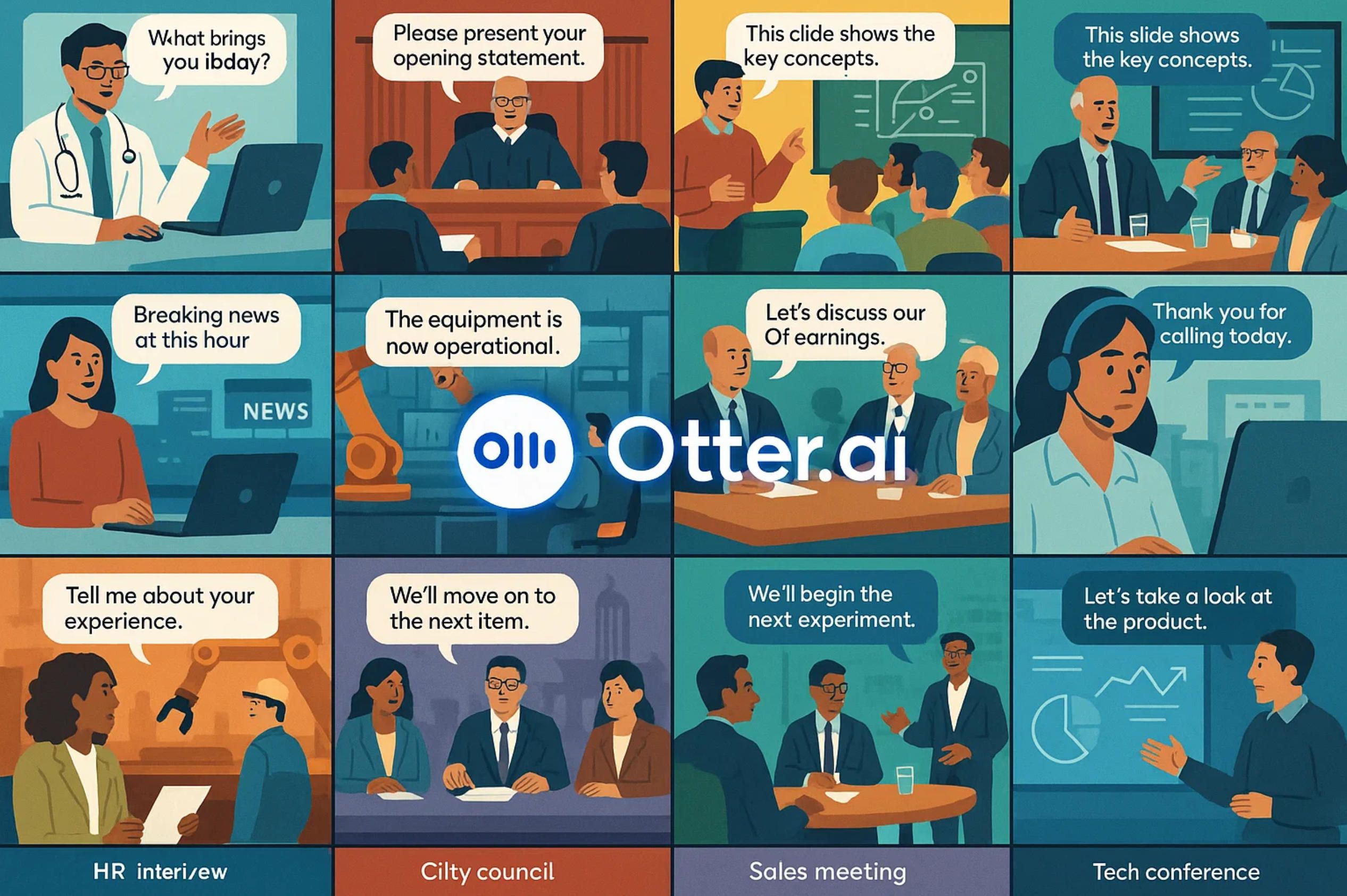
Where Otter Transcription and Otter Recording Create Real Value
Healthcare and Telemedicine — Real-time clinical dictation during tele-health visits; asynchronous note-taking for hospital ward rounds; HIPAA-safe archival of multidisciplinary meetings; automated discharge-summary drafts that flow straight into the EHR.
Legal Services — Word-perfect capture of depositions and witness interviews; searchable otter transcription of courtroom hearings; timestamped side-bar notes for contract-draft red-lining; defensible compliance logs preserved in immutable otter recording vaults.
Education and E-Learning — Live captions for lectures that boost accessibility; study-group sessions turned into shareable smart summaries; flipped-classroom content produced on the fly; instructor feedback tagged directly inside each otter recording snippet.
Media and Journalism — Rapid turnaround of interview audio into publish-ready text; newsroom fact-checking with semantic search across thousands of hours; podcast post-production that auto-generates show notes; subtitling workflows accelerated by near-zero-latency otter transcription.
Financial Services — Earnings-call capture with automatic speaker separation; MiFID II and FINRA audit trails built from encrypted otter recording; real-time risk-committee minutes searchable by keyword; voice-driven analytic dashboards that surface sentiment in analyst Q&A.
Manufacturing and Field Service — Shift-handover briefings converted into actionable checklists; maintenance technicians dictating fault reports while hands-free; multilingual safety trainings transcribed and translated instantly; factory-floor otter recordings feeding predictive-maintenance AI.
Customer Support and Contact Centers — Automatic call-center transcripts fueling sentiment models; agent coaching driven by hot-word detection inside live otter transcription; instant knowledge-base article drafts from solved tickets; redaction of PCI data inside every otter recording frame.
Human Resources and Recruiting — Interview notes that sync straight to ATS profiles; company all-hands meetings archived with searchable Q&A; performance-review conversations preserved for fair assessments; DEI workshops transcribed for accessible recaps.
Government and Public Sector — City-council sessions streamed with public captions; legislative committee hearings stored as certified otter recording evidence; citizen hotlines transcribed for rapid response; multilingual town-hall transcripts boosting transparency.
Sales and Business Development — Discovery calls logged into CRM with auto-tagged objections and next steps; coaching portals where reps replay critical otter recording moments; proposal workshops summarized into action items; revenue-forecast meetings stitched into searchable knowledge threads.
Research and Academia — Qualitative interviews instantly transformed into corpus data; lab-meeting brainstorms mined for hypotheses; focus-group otter transcription feeding NVivo or Atlas.ti; grant-writing sessions captured and indexed for citation management.
Event Management and Conferences — Live captioning for keynotes that improves accessibility; breakout-session archives delivered hours after the closing bell; post-event white-papers auto-drafted from aggregated otter recordings; sponsor analytics derived from attendee Q&A heat-maps.
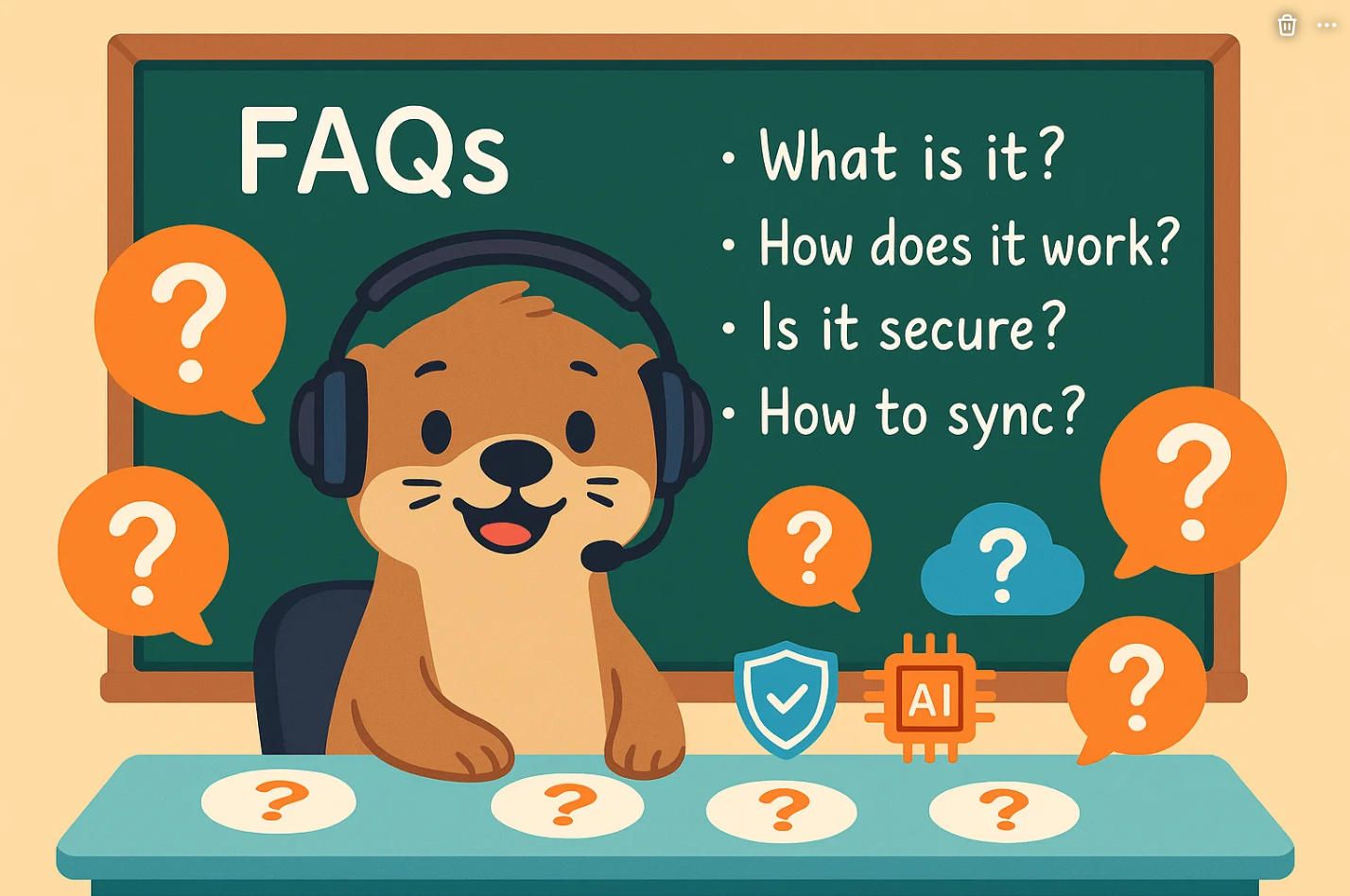
FAQ — Otter Transcription and Otter Recording with A-Bots.com
1. What is the core difference between otter transcription and a regular speech-to-text engine?
Otter transcription aligns words with speakers, timestamps, and semantic tags in real time, whereas generic engines usually output a plain block of text with no diarization or actionable metadata.
2. Does otter recording store raw audio on-device or in the cloud?
By default, all otter recording sessions are buffered locally in an encrypted partition; a policy engine decides when, or if, encrypted chunks are synced to the cloud.
3. Can I integrate otter transcription into an existing iOS or Android app without a full rebuild?
Yes. A-Bots.com wraps the Otter.ai mobile SDK inside modular Swift and Kotlin packages that drop into most CI pipelines with minimal refactoring.
4. How fast is the latency from speech to on-screen caption?
With on-device inference the end-to-end delay is typically 250–450 ms, well below the 700 ms threshold recommended for accessible live captions.
5. Is the solution HIPAA-compliant for tele-health scenarios?
Absolutely. Data flows follow HIPAA and SOC-2 controls, and PHI can be tokenized on device before optional cloud analytics.
6. What languages does otter transcription currently support?
More than 30 languages and dialects today, with A-Bots.com able to fine-tune adapters for niche vocabularies or accented English.
7. How does speaker diarization work inside otter recording?
An on-device embedding model clusters voices in real time, tags them with labels, and refines assignments post-session for accuracy.
8. Can I search across every past otter recording with semantic keywords?
Yes. Each transcript is vector-indexed, so queries like “budget risk” or “patient fall history” return the exact second those terms were spoken.
9. What happens if my users go offline during a long meeting?
Otter recording caches audio locally and switches to a smaller on-device model; when bandwidth returns, the cloud model reconciles any gaps.
10. Is there a limit on the length of a single otter recording session?
Architecturally no, but A-Bots.com recommends segmenting beyond four hours to simplify encryption keys and storage rotation.
11. How are transcription errors corrected after the fact?
End-users can inline-edit text; those edits are aggregated (anonymously) to retrain domain adapters that improve future otter transcription runs.
12. Can we feed the transcripts into our CRM or BI tool automatically?
Certainly. Webhooks and gRPC streams push finished otter transcription objects straight into Salesforce, HubSpot, Power BI, or custom data lakes.
13. What security measures protect otter recording files at rest?
Each file is sealed with ChaCha20-Poly1305 keys stored in the Secure Enclave; access demands biometric or hardware-token unlock.
14. Does the SDK support real-time translation alongside English captions?
Yes. A bilingual inference path produces dual captions—e.g., English + Spanish—without doubling latency.
15. How resource-intensive is otter transcription on older devices?
Quantized INT8 models run under 70 mW on most mid-tier phones; adaptive throttling prevents thermal spikes.
16. Can the system redact credit-card or PII data automatically?
A regex + LLM hybrid scrubber masks PCI and sensitive PII tokens before transcripts leave the device.
17. What pricing models does A-Bots.com offer for custom builds?
Fixed-scope, time-and-materials, or revenue-share contracts are available, each with transparent GPU-minute dashboards.
18. How quickly can we go from kickoff to a pilot with otter recording inside our app?
A typical proof-of-concept takes 6–8 weeks, covering SDK embed, brand theming, and secure cloud handoff.
19. Do we need a separate license from Otter.ai to deploy at scale?
Enterprise agreements can be bundled through A-Bots.com so you receive one consolidated contract and SLA.
20. What analytics are exposed to product managers post-launch?
You’ll see word-error rates, edit frequencies, sentiment scores, and engagement heatmaps—all anonymized and exportable.
21. How does otter transcription handle domain-specific jargon, like medical or legal terms?
We ingest domain glossaries during onboarding and fine-tune lightweight adapters that plug into the base model with no app update required.
22. Where do I start if I want A-Bots.com to embed otter recording and otter transcription into my product?
Visit https://a-bots.com/services/mobile, book a discovery call, and an A-Bots.com architect will outline a tailored roadmap within 48 hours.
✅ Hashtags
#OtterTranscription
#OtterRecording
#MobileAppDevelopment
#SpeechToText
#EdgeAI
#ABots
Other articles
AI Chatbot Offline Capabilities for Mission-Critical Edge Apps Cloud dropouts, privacy mandates, and mission-critical workflows expose a hard truth: traditional chatbots collapse when the signal dies. This in-depth guide unpacks the engineering science behind AI chatbot offline capabilities—model compression, encrypted vector stores, smart sync—and shows how they translate into real-world wins across aviation, maritime, healthcare, agriculture, manufacturing, energy, hospitality, and disaster response. You’ll follow A-Bots.com’s proven delivery pipeline from discovery workshop to edge deployment, understand governance safeguards for HIPAA and GDPR, and explore dozens of use-case vignettes where on-device NLP guides crews, clinicians, and field technicians without ever asking for a bar of coverage. If your organisation depends on uninterrupted dialogue, this article maps the path to a robust, compliant, offline-first assistant—ready to launch with A-Bots.com, your trusted chatbot development company.
Tome AI Deep Dive Need a presentation engine that does more than spit out pretty slides? Dive into Tome AI’s full stack: GPT-4 for narrative logic, SDXL imagery, a proprietary layout interpreter that slashes GPU spend, and a private retrieval layer that pipes Salesforce, Gong and product telemetry straight into every deck. We track EU AI-Act audit demands, Microsoft Copilot pressure, and the cost curves that decide whether viral tools survive enterprise scrutiny. Finally, see how A-Bots.com closes the loop with custom AI Chatbots that turn data-grounded decks into live conversational intelligence—so your next sales call writes its own slides while you talk.
Otter.ai Review - Real-Time Meeting Intelligence Otter.ai is no longer just a clever notetaker; it is a full-scale meeting-intelligence engine. Low-latency speech recognition captures talk in real time, while a layered LLM distills decisions, risks and tasks before the call even ends. Slide OCR fuses visuals with voice, SOC-2 safeguards calm compliance teams, and a freshly unveiled speaking agent can file Jira tickets or schedule follow-ups on command. This long-read unpacks the stack, quantifies ROI across sales, recruiting and education, and maps the competitive face-off with Microsoft Copilot, Google Duet and Zoom AI Companion.
Inside Wiz.ai From a three-founder lab in Singapore to a regional powerhouse handling 100 million calls per hour, Wiz.ai shows how carrier-grade latency, generative voice, and rapid localisation unlock measurable ROI in telco, BFSI and healthcare. This long-read unpacks the company’s funding arc, polyglot NLU engine, and real-world conversion metrics, then projects the next strategic frontiers—hyper-personal voice commerce, edge inference economics, and AI-governance gravity. The closing blueprint explains how A-Bots.com can adapt the same design principles to build bespoke AI agents that speak your customers’ language and turn every second on the line into revenue.
Beyond Level AI Conversation-intelligence is reshaping contact-center economics, yet packaged tools like Level AI leave gaps in data residency, pricing flexibility, and niche workflows. Our deep-dive article dissects Level AI’s architecture—ingestion, RAG loops, QA-GPT scoring—and tallies the ROI CFOs actually care about. Then we reveal A-Bots.com’s modular blueprint: open-weight LLMs, zero-trust service mesh, concurrent-hour licensing, and canary-based rollouts that de-risk deployment from pilot to global scale. Read on to decide whether to buy, build, or hybridise.
Tome AI presentation Tome AI’s promise—“write a prompt, get a deck”—is only the opening act. Our long-read unpacks the entire production line: semantic planning, responsive grid layouts, diffusion-generated imagery, live data connections and Git-like branching for collaboration. You’ll see how BrandGuard locks design compliance, Engage Analytics surfaces slide-level behavior, and Governance Studio keeps legal teams happy. Finally, we look beyond auto-slides to conversational interfaces that let stakeholders ask the deck questions in real time. If you’re ready to embed a secure AI Chatbot into your Tome workflow, A-Bots.com delivers the blueprint—from RAG retrieval pipelines to prompt-level audit logs.
Tome App vs SlidesAI A hands-on, 3-section deep dive that pits Tome App vs SlidesAI across setup, narrative refinement, and team-scale governance—so you’ll know exactly which AI deck builder speeds your next pitch. (Spoiler: if you need something custom, A-Bots.com can craft it.)
Wiz AI Chat Bot Wiz AI isn’t just another chatbot tool — it’s a full-stack voice automation platform built for Southeast Asia’s linguistic and cultural complexity. In this comprehensive, no-fluff guide, we walk you through the entire lifecycle of creating and deploying a human-like conversational agent using Wiz AI. Learn how to build natural call flows, manage multilingual NLP, personalize in real time, and activate smart triggers that behave like skilled agents. We also explore the hidden features that turn ordinary users into AI power designers — from behavioral analytics to UX timing control. And if you need a truly custom solution, A-Bots.com can help you go even further.
Top stories
Copyright © Alpha Systems LTD All rights reserved.
Made with ❤️ by A-BOTS
